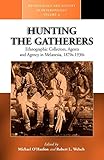Hunting the Gatherers : Ethnographic Collectors, Agents, and Agency in Melanesia 1870s-1930s / ed. by Robert L. Welsch, Michael O'Hanlon.
Material type: TextSeries: Methodology & History in Anthropology ; 6Publisher: New York ; Oxford : Berghahn Books, [2001]Copyright date: ©2001Description: 1 online resource (306 p.)Content type:
TextSeries: Methodology & History in Anthropology ; 6Publisher: New York ; Oxford : Berghahn Books, [2001]Copyright date: ©2001Description: 1 online resource (306 p.)Content type: - 9781571815064
- 9780857456915
- online - DeGruyter
| Item type | Current library | Call number | URL | Status | Notes | Barcode | |
|---|---|---|---|---|---|---|---|
 eBook
eBook
|
Biblioteca "Angelicum" Pont. Univ. S.Tommaso d'Aquino Nuvola online | online - DeGruyter (Browse shelf(Opens below)) | Online access | Not for loan (Accesso limitato) | Accesso per gli utenti autorizzati / Access for authorized users | (dgr)9780857456915 |
Frontmatter -- CONTENTS -- List of Illustrations -- Notes on contributors -- Preface -- 1. Introduction -- 2. Gathering for God: George Brown and the Christian Economy in the Collection of Artefacts -- 3. Exploring Tensions in Material Culture: Commercialising Ethnography in German New Guinea, 1870–1904 -- 4. ‘Before it has Become too Late’: The Making and Repatriation of Sir William MacGregor’s Official Collection from British New Guinea -- 5. Surveying Culture: Photography, Collecting and Material Culture in British New Guinea, 1898 -- 6. Collecting Pygmies: the ‘Tapiro’ and the British Ornithologists’ Union Expedition to Dutch New Guinea, 1910–1911 -- 7. One Time, One Place, Three Collections: Colonial Processes and the Shaping of Some Museum Collections from German New Guinea -- 8. The Careless Collector: Malinowski and the Antiquarians -- 9. Felix Speiser’s Fletched Arrow: A Paradigm Shift from Physical Anthropology to Art Styles -- 10. On His Todd: Material Culture and Colonialism -- 11. Reverse Trajectories: Beatrice Blackwood as Collector and Anthropologist -- 12. Epilogue -- Index
restricted access online access with authorization star
http://purl.org/coar/access_right/c_16ec
Between the 1870s and the 1930s competing European powers carved out and consolidated colonies in Melanesia, the most culturally diverse region of the world. As part of this process, great assemblages of ethnographic artefacts were made by a range of collectors whose diversity is captured in this volume. The contributors to this tightly-integrated volume take these collectors, and the collecting institutions, as the departure point for accounts that look back at the artefact-producing societies and their interaction with the collectors, but also forward to the fate of the collections in metropolitan museums, as the artefacts have been variously exhibited, neglected, re-conceived as indigenous heritage, or repatriated. In doing this, the contributors raise issues of current interest in anthropology, Pacific history, art history, museology, and material culture.
Mode of access: Internet via World Wide Web.
In English.
Description based on online resource; title from PDF title page (publisher's Web site, viewed 25. Jun 2024)


